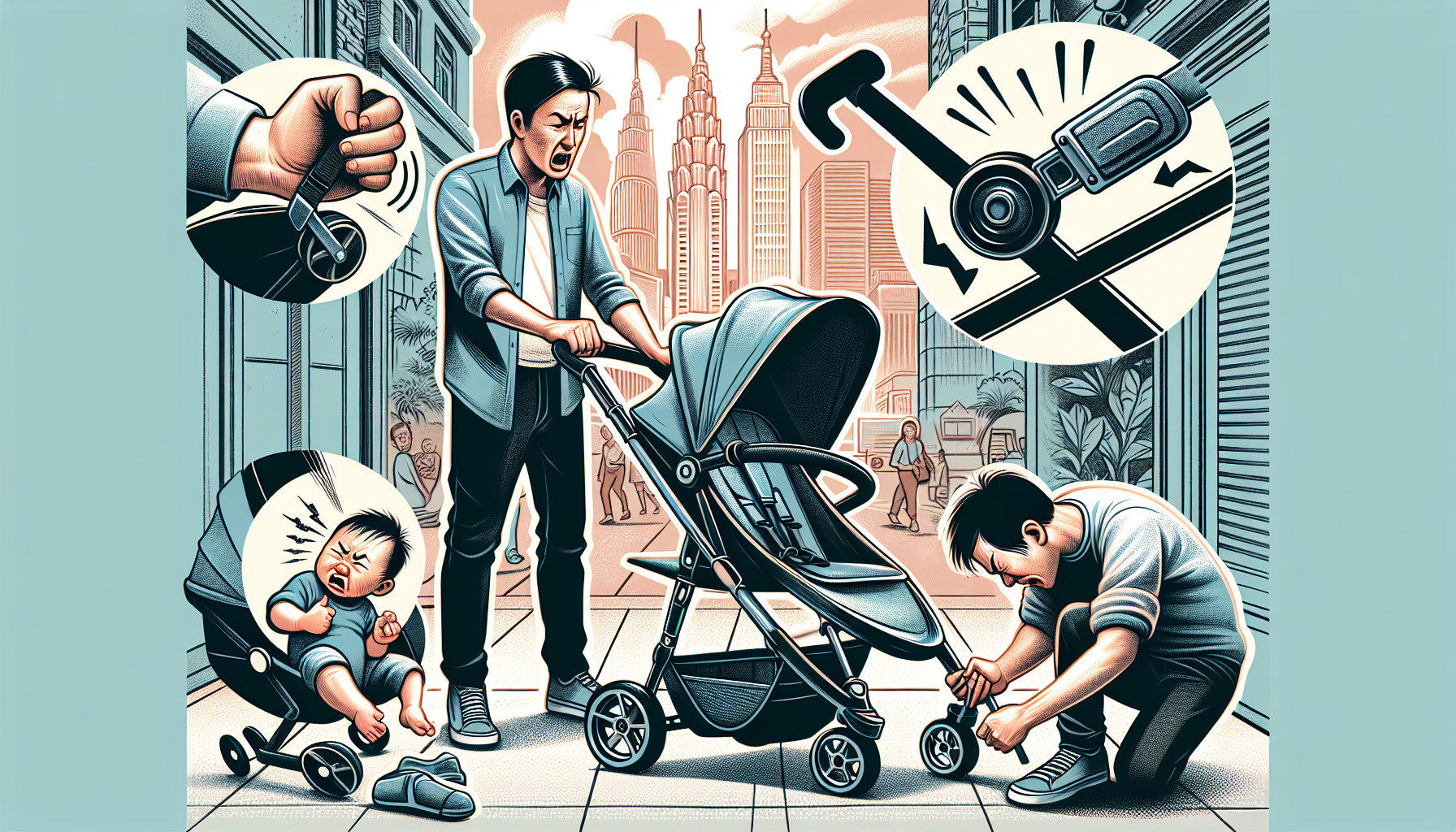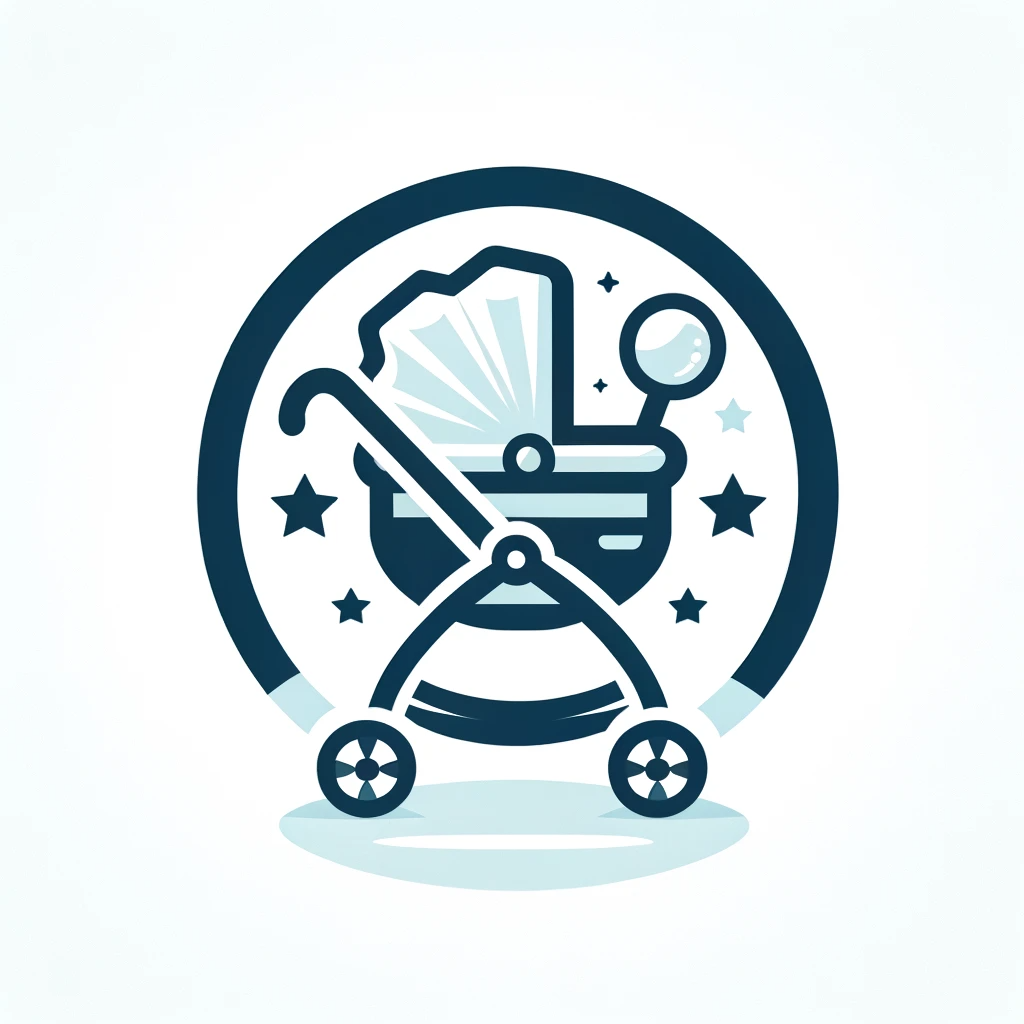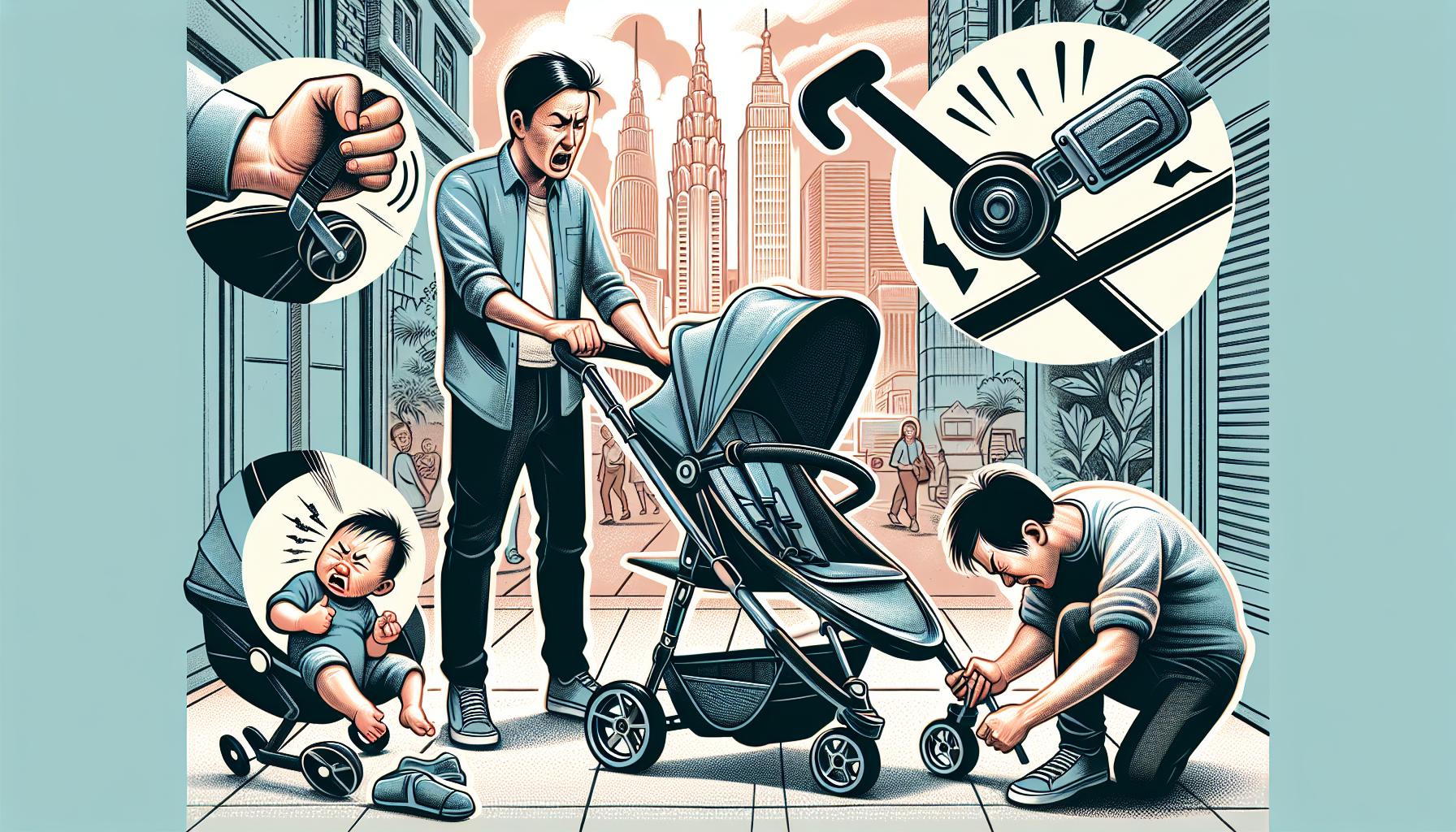You, as an expectant or new parent, may be eager to take your little one for a stroll in their brand new stroller. However, before you hit the pavements and parks, it’s important to be aware of common stroller problems that could potentially hinder your experience. From faulty brakes to uncomfortable seating, this article will shed light on the issues you might encounter and provide practical solutions to ensure a smooth and enjoyable stroll for both you and your baby.

I. Maneuverability
A. Difficulty steering the stroller
When it comes to maneuverability, one common problem that parents often face with strollers is the difficulty in steering them. This issue can arise due to various factors, such as the placement of the wheels and the overall design of the stroller. If the wheels are not aligned properly or lack an effective steering mechanism, it can make navigating through crowded spaces or tight corners a challenging task.
B. Inability to make sharp turns
Another aspect of maneuverability is the stroller’s ability to make sharp turns. Some strollers may have a wider wheelbase or a design that restricts the turning radius, making it cumbersome to maneuver through narrow hallways or crowded streets. This can be particularly frustrating for parents who require a stroller that is nimble and agile to keep up with their active lifestyle.
C. Uneven wheel alignment
Uneven wheel alignment is yet another common issue that affects the maneuverability of strollers. This problem can result from wear and tear or improper assembly of the stroller. When the wheels are not aligned correctly, it can lead to a bumpy ride and make pushing the stroller feel like a constant struggle. Additionally, uneven wheel alignment can also cause the stroller to veer to one side, making it difficult to keep it on a straight path.
II. Folding and Unfolding
A. Struggles with folding the stroller
Folding and unfolding a stroller should ideally be a simple and hassle-free process. However, many parents encounter difficulties in this regard, especially if the stroller has a complex folding mechanism or if the instructions provided are unclear. Struggling to fold the stroller can be particularly inconvenient when you are in a hurry or have limited space in your car or home.
B. Issues with unfolding the stroller
Just as folding the stroller can pose challenges, unfolding it can also be problematic. Some strollers may have mechanisms that require a certain sequence of steps to unfold properly, and if not followed correctly, it can result in frustration and wasted time. This can be especially bothersome when you are juggling multiple tasks or trying to manage a restless child.
C. Latching mechanism malfunction
A malfunctioning latching mechanism is another common problem encountered during the folding and unfolding process. If the latch fails to secure the stroller in its folded or unfolded position, it can pose a safety hazard to both the child and those around them. Moreover, a faulty latch can also lead to the stroller unintentionally collapsing or unfolding, causing potential injury or damage.
III. Braking System
A. Ineffective brake
The braking system of a stroller plays a crucial role in ensuring the safety of your child, as it allows you to secure the stroller in place when needed. However, some strollers may have brakes that are ineffective or do not provide sufficient stopping power. This can be a significant concern, especially when navigating hilly terrains or busy streets where the ability to stop the stroller promptly is crucial.
B. Brake lock failure
In addition to an insufficient braking system, brake lock failure is another issue that parents may encounter. The brake lock is designed to keep the stroller from moving when engaged, offering stability and preventing accidents. However, if the brake lock fails to engage properly or disengages unexpectedly, it can put the child at risk and cause unnecessary stress for parents.
C. Brake sensitivity
Some strollers may exhibit an overly sensitive braking system, which can lead to sudden stops or difficulty in maintaining a smooth pace. This issue can be frustrating for parents, especially when trying to navigate crowded areas or when the child is asleep in the stroller. A braking system that is too sensitive can disrupt the stroller’s overall maneuverability and potentially lead to discomfort for both the child and the parent.
IV. Durability and Materials
A. Worn-out fabric
Durability is an important aspect to consider when purchasing a stroller. Over time, the fabric used in strollers can start to wear out, lose its color, or become damaged due to regular use and exposure to the elements. When the fabric deteriorates, it not only affects the aesthetics of the stroller but also compromises its functionality. Additionally, worn-out fabric may be less comfortable for the child and may not provide adequate protection against the weather.
B. Loose or broken parts
Loose or broken parts can significantly impact the overall durability and usability of a stroller. Mechanical components such as wheels, handles, or folding mechanisms that become loose or detached can render the stroller unsafe and unreliable. Moreover, loose parts may pose a choking hazard or cause injury if they detach while the stroller is in use. It is important to regularly inspect the stroller for any loose or broken parts and address the issue immediately to ensure the safety of your child.
C. Weak construction
The construction and build quality of a stroller are essential for its longevity and stability. Strollers made with weak or subpar materials are more prone to damage and wear down faster over time. Weak construction can result in frames that bend or break, compromising the stroller’s structural integrity and putting the child’s safety at risk. Investing in a stroller with strong and robust construction is crucial to ensure its durability and reliability.
V. Comfort and Safety
A. Lack of padding or cushioning
The comfort of your child should be a top priority when selecting a stroller. However, some strollers may lack adequate padding or cushioning, resulting in an uncomfortable experience for the child. Insufficient padding can make the stroller feel hard and uncomfortable for extended periods, which may lead to restlessness or crankiness. A stroller with ample padding and cushioning can provide a cozy and soothing environment that facilitates longer and more enjoyable outings.
B. Non-adjustable seating positions
Every child is unique, and their seating preferences may vary. Unfortunately, some strollers offer limited or non-adjustable seating positions, which can make it challenging to find a comfortable and ergonomic seating position for your child. The inability to adjust the seat angle or the backrest can lead to discomfort, especially during longer outings or when the child wants to sit up or recline. A stroller that provides multiple adjustable positions ensures that your child can find the perfect seating arrangement for their comfort and support.
C. Loose or unreliable safety harness
Safety is of utmost importance when it comes to strollers, and a loose or unreliable safety harness can undermine the overall safety of the child. A secure and properly functioning safety harness is essential to prevent accidents or falls. However, some strollers may have harnesses that are difficult to adjust or have buckles that come loose easily. This can create a safety hazard as the child may be at risk of slipping or sliding out of the stroller.
VI. Wheel Performance
A. Noisy or squeaky wheels
Wheel performance is a critical factor in determining the overall smoothness and ease of pushing a stroller. Unfortunately, some strollers may have wheels that produce excessive noise or squeak when in use. This can not only be annoying for the parents but can also disturb the child and disrupt their peaceful ride. Noisy wheels can be caused by a variety of factors, such as inadequate lubrication or poor wheel quality.
B. Difficulty traversing uneven terrain
Strollers that struggle to navigate uneven or rough terrain can pose significant challenges for parents who enjoy outdoor activities or live in areas with less-developed infrastructure. Uneven terrain can include gravel paths, grassy areas, or cobblestone streets, which are more difficult to maneuver through. If a stroller is not designed or equipped to handle such terrain, it can result in an uncomfortable ride for the child and increased effort for the parent.
C. Wheels getting stuck or jammed
Having wheels that get stuck or jammed is another common problem faced by parents using strollers. This issue can occur when debris, such as pebbles or twigs, gets lodged in the wheels or when the wheels themselves are not properly aligned. Wheels that get stuck can make pushing the stroller incredibly difficult and may require frequent stops to clear out the obstruction. This inconvenience can be particularly frustrating when you are on the go or rushing to get somewhere.
VII. Storage Space
A. Insufficient storage capacity
For parents, the convenience of having ample storage space is vital, as it allows them to carry essential items and supplies while on the move with their child. However, some strollers may have limited storage capacity, which can be problematic when you need to carry a diaper bag, extra clothing, snacks, or toys. Insufficient storage space can significantly impact outings, as it may require parents to carry additional bags or compromise on the items they can bring along for their child’s comfort.
B. Difficult access to storage basket
Even if a stroller has an adequate storage basket, accessing it easily can be a challenge. Some strollers have storage baskets that are positioned too low or have design elements that restrict access from certain angles. This can make it difficult to retrieve items quickly or to store items without any hassle. Easy and convenient access to the storage basket is crucial for efficiently managing your child’s essentials while on the go.
C. Lacking extra compartments
In addition to a spacious storage basket, having extra compartments in a stroller can provide further convenience and organization. Unfortunately, some strollers may lack additional compartments for smaller items such as keys, phones, or wallets. The absence of these compartments can make it harder to keep essential items easily accessible and may necessitate carrying additional bags or accessories for storing smaller belongings.
VIII. Size and Weight
A. Heavy and difficult to carry
The weight of a stroller is an important consideration, as it directly affects how easy it is to transport and maneuver. Strollers that are excessively heavy can pose a physical strain on parents, especially when lifting, carrying, or storing the stroller. This can become a significant issue for those who may have limited upper-body strength or who frequently need to fold and carry the stroller in various situations, such as when using public transportation or going on trips.
B. Bulky and space-consuming when folded
In addition to the weight, the size and folding mechanism of a stroller can also impact its overall portability. Bulky strollers that take up a large amount of space when folded can present challenges when transporting or storing them. They may require additional trunk space in the car or may be difficult to fit into tight storage areas at home or in public places. A stroller that folds compactly and efficiently can greatly ease the logistical aspects of using and transporting it.
C. Inconvenient dimensions for transportation
Considering the dimensions of a stroller is essential, particularly when it comes to transportation. Some strollers may be too wide to fit through standard doorways or narrow spaces, making it challenging to navigate public places or move freely in crowded areas. Similarly, strollers that are too long may be inconvenient to handle, especially when making sharp turns or maneuvering in confined spaces. Choosing a stroller with dimensions suitable for your specific needs and environment can significantly enhance your overall experience.
IX. Canopy and Sun Protection
A. Limited sunshade coverage
One important feature of a stroller is the canopy, which provides protection from the sun’s harmful rays. However, some strollers may have canopies that offer insufficient coverage, leaving a significant portion of the child exposed to direct sunlight. This inadequate sunshade coverage can be concerning, as it increases the risk of sunburn and discomfort for the child. A stroller with a generously-sized canopy that provides ample shade can help safeguard your child’s delicate skin from the sun’s harmful effects.
B. Flimsy or unstable canopy
While adequate coverage is crucial, it is equally important to have a canopy that is sturdy and stable. Some strollers may have canopies that are flimsy or easily affected by wind or slight movements, leading to instability. An unstable canopy can fail to provide consistent protection from the elements, potentially allowing rain, wind, or sunlight to reach the child. Investing in a stroller with a robust and secure canopy ensures reliable protection and peace of mind for parents.
C. Difficulty adjusting canopy position
Adjustability is another factor to consider when evaluating a stroller’s canopy. Parents often need the flexibility to adjust the canopy’s position to suit changing weather conditions or to allow the child to see and interact with their environment. However, some strollers may have canopies that are difficult to adjust or lack multiple positions, limiting the parent’s ability to customize the level of shade or visibility for their child. A stroller with a user-friendly and versatile canopy adjustment system can enhance the overall comfort and enjoyment of outings.
X. Handlebar Design
A. Uncomfortable grip
The handlebar of a stroller should provide a comfortable grip to ensure ease of use and prevent discomfort during extended outings. However, some strollers may have handlebars that are ergonomically unfriendly, which can lead to hand or wrist fatigue. Additionally, certain materials used for handlebar grips can cause sweating or make it harder to maintain a secure grip. A stroller with a well-designed and comfortable handlebar grip can significantly enhance the parent’s overall experience.
B. Non-adjustable handlebar height
Parents come in different shapes and sizes, and having a non-adjustable handlebar height can create a less comfortable pushing experience. Strollers with fixed handlebars may force taller parents to stoop or hunch over, leading to potential back or posture problems. On the other hand, shorter parents may find it challenging to maintain a comfortable and ergonomic grip on the handlebar. A stroller with an adjustable handlebar height allows parents of various heights to push the stroller comfortably and maintain proper posture.
C. Handlebar coming loose or detaching
The handlebar is a critical component of a stroller, and its stability and integrity should never be compromised. However, handlebars that come loose or detach unexpectedly can be a safety hazard. A loose or wobbly handlebar can make it difficult to control the stroller and compromise your ability to steer or brake effectively. Regularly checking the handlebar for any signs of loosening or detachment is crucial to ensure the continued safety and reliability of the stroller.

